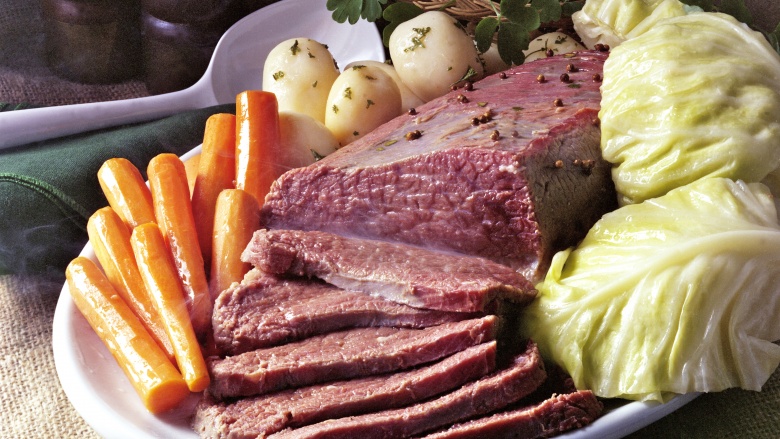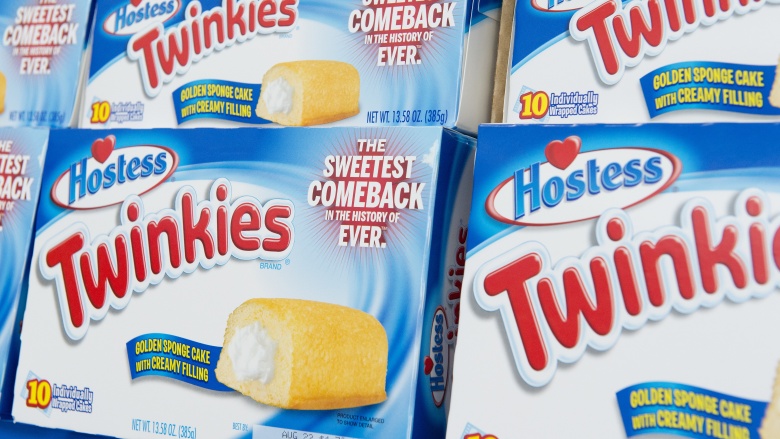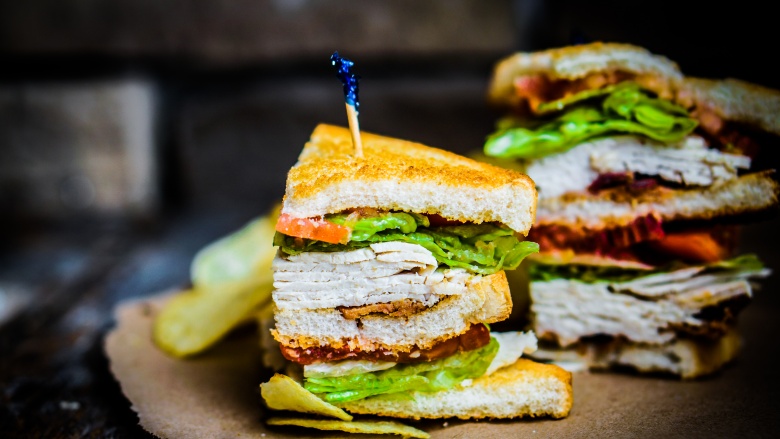Food Origin Myths Everyone Believes Are True
The variety of foods stocked in grocery stores and on dining room tables throughout the Western world is pretty impressive. Whether you're talking about seasonal favorites or weekly staples, chances are good that you have a cabinet full of spices, the makings of a sandwich, and maybe even a box of guilty-pleasure Twinkies hiding in a cupboard. You've probably heard stories about how all these things came to be, too, but you might be surprised to find that a lot of those stories just aren't true.
Corned beef and cabbage is not from Ireland
Every St. Patrick's Day, tables across the U.S. are filled with what's advertised as an authentic Irish dinner. It's corned beef and cabbage, and even though it goes great with Guinness (like a lot of things), it isn't from Ireland.
Corned beef has had something of a rocky road on its way to becoming a St. Patrick's Day favorite. The term "corned beef" goes back to some point in the 17th century, and it wasn't an Irish term. It was British, and it described the salt crystals that were used to preserve Irish beef before it was shipped to England and the colonies. Until the British land and property grab, cows had been much more valuable as work animals and for their milk than for their meat, but when the British came, that changed in a bad way. Suddenly, Irish land was being used to produce food for the British Empire, including beef preserved with corn kernel-sized salt crystals. That original corned beef was very, very different than your staple March meal, and it wasn't even eaten by the Irish. Instead, it was exported in massive quantities while the Irish themselves starved. The only thing the laws of the British landowners would allow them were potatoes and, if they were lucky, a bit of ham. Fast-forward a bit through the potato famine, and huge numbers of Irish immigrants were moving to the United States.
Many Irish immigrants settled in New York City, and while they were doing better than they had under British rule, they still weren't doing great. With beef brisket one of the cheapest cuts of meat that were on the shelves of the kosher butchers in their neighborhoods, that became a go-to staple of their diet. It was called corned beef, but the product that New York City's immigrants were eating wasn't the same beef that their families had raised for British families. The city's Jews and the Irish became close allies in the face of outside prejudices, and it was the combination of brisket from kosher butchers and a new process that was needed to soften this tough cut of meat that created the corned beef we think of today.
It's remained an American thing. Head to Ireland today and you definitely won't see corned beef on any menu. If you're looking for an authentic Irish meal for St. Patrick's Day, you'll have to try lamb or bacon. (But Irish bacon isn't the same as American bacon).
Margaret Thatcher had nothing to do with soft serve
One of the big reasons the heat of the summer months is bearable is because of soft serve ice cream. It's one of the high points of August, but the claims that Britain's Iron Lady had something to do with our favorite summertime treat, that was a little weird.
Fortunately, it's not true. While Margaret Thatcher did have a degree in chemistry from Oxford and did briefly work for the company (J. Lyons & Company) that made Mr. Whippy famous, that was years after and an ocean away from where soft serve was really born. As far as food historians can tell, soft serve was stumbled on simultaneously by J.F. McCullough (who went on to found Dairy Queen) and Tom Carvel (who founded Carvel), and they were serving it as early as 1938. While McCullough was pitching his product in a local ice cream shop, Tom Carvel was turning lemons into lemonade. After his ice cream truck broke down and the ice cream started to melt, he sold it as soft serve. So where did the myth come from?
From what historians have been able to piece together, it was first mentioned by Britain's left wing as a description for her politics. They invented the story that she had developed the technology behind turning ice cream into soft serve, and that the story was a badly disguised metaphor for the political spectrum of the day.
Fortune cookies aren't from China
They're a staple with every Chinese meal, whether you're out a restaurant or picking up something to go on the way home. There are always a few fortune cookies to wrap up the meal. But they aren't authentic, and when it came time to make an official ruling on the story behind the fortune cookie's history, it was such a big deal that the decision went to court.
Even as the Irish settled in New York City, Chinese and Japanese immigrants settled in California. That planted the seeds of a rivalry that led to two entirely different places insisting that they had been the original inventors of the fortune cookie as we know it today. According to one story, it was invented by David Jung (head of Los Angeles's Hong Kong Noodle Company) in 1918. On the other side of the argument was the claim that the invention happened nine years earlier in the kitchens of Makoto Hagiwara's Japanese Tea Garden. The verdict was split, with the final decision that it was created in San Francisco.
Food historian Yasuko Nakamatchi did a little more detective work, though, and she found the roots of today's fortune cookies can probably be traced back to a group of family bakeries in Kyoto. They were known for their "fortune crackers," treats that had fortunes attached to the outside. They're a far cry from today's cookies, though, and were flavored with sesame and miso. The shift of fortune cookies to Chinese cuisine likely happened during World War II with the closing of countless Japanese restaurants and bakeries even as their owners and workers were shuttled off to internment camps. Chinese chefs stepped up, Chinese food became popular, and the fortune cookies was adopted into a new family.
Vegetarian sausages weren't made for vegetarians
Seems logical, right? Today's world is filled with people who are making a conscious decision to go meat-free. So, it just seems right that vegetarian sausages were made for people who wanted to make a difference.
Not so fast. The first vegetarian sausages were created out of necessity, not idealism. Even in the earliest days of World War I, food shortages were a regular problem on all sides. People needed to make do with what they had, and it was a German inventor in Cologne who came up with the idea of repurposing some nonmeat items into what had long been a German favorite. Konrad Adenauer took ingredients they had plenty of (soya, corn, barley, ground rice, and flour) and created the Kolner wurst. Unfortunately, what the Kolner wurst didn't have (aside from meat) was much in the way of flavor, so it completely failed to impress any of the locals who tried it. Flavorings and techniques have gotten much better in the intervening years, and Adenauer's idea was eventually a success.
Twinkies underwent a major change
Even if you hate them, sometimes they're just a guilty pleasure. Everyone has cravings for Twinkies every so often, and there's nothing wrong with that. We won't judge. We will tell you, however, that the Twinkies you're enjoying today aren't the ones that were first envisioned as a spongy, tasty treat. (And don't believe the legends about their 20-year shelf life; they last about 45 days.)
When Twinkies were originally created in the 1930s, they were the complete opposite of the processed cake you get today. All the flavors in the Twinkie were natural, and the filling was made from real bananas. Twinkies were said to have the texture of a banana cream pie, and they spoiled pretty quickly because of a lack of preservatives.
World War II changed all that. When rationing started to seriously impact the way people were eating and no end was in sight, bananas became a poster child for foods that were impacted. (A British jingle even advertised, "Yes, we have no bananas, we have no bananas today!") With no bananas, the company behind Twinkies, the Continental Baking Company, switched to vanilla and didn't look back.
The Earl of Sandwich didn't invent the sandwich
We've all heard the story that says the Earl of Sandwich was such a prolific gambler that he couldn't even be bothered to get up from his nightly card game to grab a bite to eat. He requested a piece of meat be served to him between two pieces of bread, and the sandwich was born.
The sandwich actually dates back much farther than that, all the way to around 3,300 years ago and a Jewish meal called the Seder. These meals are in remembrance of the Jews' flight from Egypt, and one of the traditional dishes that has been served for thousands of years is one made from matzo, bitter herbs, and lamb. It was around 2,000 years ago that a sage named Hillel recorded how he ate those ingredients: all stacked together. It's called the Hillel sandwich now, and in Hebrew, it's called a korech. The word literally means "to wrap."
The story of the Earl of Sandwich gets repeated all the time, but what's usually left out is the rather colorful history of the earl himself. The earl, John Montagu, was one of the charter members of the Hellfire Club, and while it's next to impossible to tell which stories are real and which are exaggerated, we do know that he belonged to a number of elite British clubs, kept a 16-year-old mistress (he was in his 40s) while his wife was declared insane, and was said to be one of the most non-traditional of Francis Dashwood's associates.
GMOs aren't new
Thinking of GMOs can make people feel a little iffy about some of the things on the plate. We're hearing all about how genetically modifying our foods to make crop yields higher, fruits and vegetables bigger, and animals more productive is probably a bad thing. (We all watched Jurassic Park, so we know what happens when you start mucking about with genes.) But if you think this is some new horror released on us by modern science, that's not true.
GMOs have been around for around 8,000 years, and the now-humble sweet potato was among the first. Researchers from the International Potato Center in Lima, Peru, were able to trace genes that were integrated into different varieties of sweet potato from the presence of particular types of bacteria in the soil. About the same time the sweet potato's genome was changed by this bacterial DNA, our ancestors started picking, planting, and transporting this new food. That makes sweet potatoes the first known GMO, and the way the bacteria changed the plant's genome to make it edible is similar to what happens in a lab today.
Lobsters weren't always an expensive, desirable food
If you're trying to think of posh foods that convey wealth and sophistication, lobster is on the list. But that wasn't always the case, and when we first started eating this crustacean from the deep, it had a very different connotation.
When colonists first settled along the shores of the New World, they had a problem that, today, might sound like an absolute delight to some. Records tell of lobsters washing up on the East Coast in drifts, covering the beach like little, pincher-filled claws of angry. They were so abundant that they were beach garbage, and the only good use for them was as bait for other fish or last-resort food. And there was nothing else a lot of the time, making lobster as resented as that last box of questionable ramen noodles in the back of your cupboard.
If lobster shells were a huge part of your household's menu, you weren't doing so well in life. Lobster was reserved for the poor, criminals, and servants. Servants even hated it, to the point where courts had to step in and rule that servants couldn't be forced to eat lobster more than three nights a week. It was only when that area became known for its summer tourism that lobster became a good thing. At the end of the 19th century, people were heading to New England to vacation, and lobster became what the elite could afford to eat on vacation.
Spices were never used to hide rotten meat
Spices, the popular tale goes, got their start in the Middle Ages. Times were tough, and people needed to eat what they could get. It wasn't always the freshest stuff, so they started using spices and seasonings to cover the rancid taste of what they were eating. Right?
If there's an opposite to the truth, this is it. Spices in the Middle Ages were incredibly rare, very valuable, and very expensive. If you couldn't afford good meat, you certainly couldn't afford spices. It wasn't just a matter of going down to the grocery store to pick some up. Things like nutmeg, cinnamon, and ginger could only be sourced from the Far East.
So what's the deal? Food historians have traced it back to a single passage in what's essentially mistranslation. Jack Cecil Drummond was an adviser to the British Ministry of Food in the 1930s and 1940s, and he wrote a book called The Englishman's Food. It was a greatest hits version of English food dating back to prehistoric times, and in it, he references "greene" meat in the Middle Ages and the rather shady practice of hiding the fact that it's gone off so it could still be sold. He's basing that on a mistranslation of "greene," though, a word that actually refers to the process of aging, not spoilage.
People in the MIddle Ages might not have understood the biological reasons why they got sick from eating bad meat, but they understood the effects. Drummond himself makes reference to it elsewhere in his text, specifying that there were stiff penalties in place for anyone who was caught selling rotten meat. But, the mistranslation makes for a great story, so maybe that's why it stuck.
America's apples weren't meant for eating
As Europeans pushed westward and settled more and more of North America, Johnny Appleseed moved west, too, planting apples as he went. They turned into an invaluable food source for the pioneers, and the orchards that he started were a lifeline for the brave settlers.
Nope. The origin of the apple orchards of the American West (and the continued popularity of apples today) has less to do with eating and more to do with drinking. When the government was trying to convince people to head west, they offered a lucrative deal. New settlers would be given 100 acres, as long as they developed the land. That included planting 20 peach trees and 50 apple trees in the first three years they were on the land.
Who has time to do that? Enter John Chapman, who saw an opportunity and took it. He planted trees for the new settlers, but there was a slight problem. Chapman was a member of the Swedenborgian Church, and his beliefs meant that all his trees needed to be planted from seeds rather than from cuttings of other trees. And that all meant the apples that they eventually bore were the kind that you absolutely didn't want to eat. They were incredibly bitter, but they were also perfect for something else: cider. Chapman's orchards no longer stand, either. When Prohibition hit, government enforcers were sent out with axes to chop down the trees and make sure no one was using the apples to produce alcohol any more.










